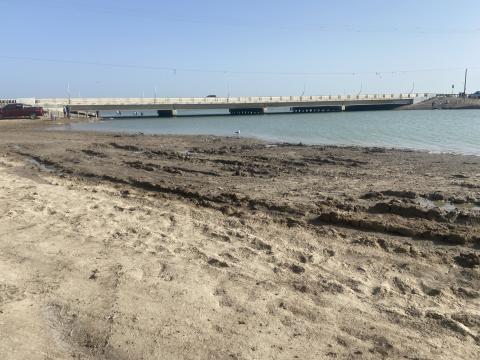The Texas Trustee Implementation Group’s Bahia Grande Hydrologic Restoration project is yielding early monitoring results that indicate the project is meeting its aim of increasing tidal exchange between the Bahia Grande coastal wetlands complex and the Brownsville Ship Channel and Gulf of Mexico. Restoring tidal exchange between the watershed and the channel will decrease salinities in the wetlands and improve the ecological functions of nearly 9,600 acres of habitat for a variety of fish, shellfish, and migratory waterfowl.
Completed in July 2022, the project widened, deepened, and stabilized the existing connection, called the Pilot Channel, from a bottom width of 15 feet to 150 feet and depths from three feet to nine feet.
Once the canal improvements were completed, a team from the University of Texas Rio Grande Valley monitored first-year flow and tidal exchange and found a nearly three-fold increase in the pre- and post-widening tidal exchange rates, that is, from a 2.5% tidal exchange to a 22% tidal exchange. This result aligns with the Trustees’ target of a two- to three-fold increase in tidal exchange ratios or a 16 to 30% tidal exchange. University of Texas faculty and graduate students will continue monitoring the project for four more years.
The area around the Bahia Grande Watershed has a long history of physical alterations meant to provide economic benefits. Unfortunately, these changes caused profound damage to the Bahia Grande/Laguna Larga/Little Laguna Madre complex, which is part of the Laguna Atascosa Wildlife Refuge. Local, state and federal government has worked to mitigate those negative impacts for decades. One of the most damaging alterations was the construction of the Brownsville Ship Channel in 1936 for improved movement of goods from the Gulf of Mexico to the interior of Cameron County, Texas. As the channel was dredged, the dredged material was cast to the side of the canal, a common practice in those days, but it had the devastating effect of cutting off the Bahia Grand Watershed to the Gulf of Mexico. The once highly productive estuary, including its habitat for fish and birds, was converted into a huge dustbowl that regularly shrouded surrounding homes, farms, and roadways in a blanket of fine dust.
The Bahia Grande Hydrologic Restoration project is part of a suite of projects funded by two Deepwater Horizon oil spill settlements, including the 2016 history-making $8.8 billion Natural Resources Damage Assessment settlement. These projects will protect, enhance, restore, and connect wildlife habitat extending throughout the south Texas coast.
We also send updates out via email. If you haven't already, please take the opportunity to sign up for e-mail updates today to receive the latest news from all the Deepwater Horizon Trustees.


